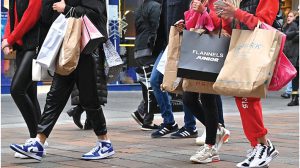BLOOMBERG
Americans are still spending. And the country’s biggest retailers are still warning that the party is at risk of fizzling. Walmart Inc, Target Corp and Home Depot Inc all topped Wall Street’s profit estimates in their fiscal second quarters, which ended in late July. In that way, at least, the results reinforced the picture of a resilient consumer after US retail sales last month beat expectations. Strong spending so far this year prompted economists to lift their growth outlook in the latest Bloomberg survey.
But there were signs of weakness for the retailers, too, and executives were at pains to share their worries for the rest of the year. Consumers have yet to regain their appetites for big-ticket items and nonessentials, and that dragged down sales at Target and Home Depot despite their better-than-expected profits. In addition, executives warned that new pressures such as rising interest rates and student-loan repayments could take the wind out of consumers’ sails during the second half.
“Jobs, wages, and pockets of disinflation are helping our customers,” Walmart Chief Executive Officer Doug McMillon said on a call with analysts, summing up the dueling economic forces on his customers. “But rising energy prices, resuming student loan payments, higher borrowing costs, and tightening lending standards — and a drawdown in excess savings — mean that household budgets are still under pressure.”
Indeed, excess savings from the pandemic and higher wages in a historically tight labour market have been fuelling purchases for a while. But consumers have increasingly turned to borrowing as savings wind down — just as credit tightens. Wage growth has slowed from the peaks of last year. And the student-loan repayments that McMillon is worried about will resume in October, hitting the spending power of millions of households.
That’s also a big risk for Target, where signs of a less exuberant consumer were perhaps clearest. The retailer’s sales fell the most in almost seven years as demand slid in such categories as apparel, home goods and hardlines, a category that includes electronics and toys. Despite a strong profit performance in the second quarter and robust sales of food and beauty products, the Minneapolis-based company cut its earnings forecast for the year as a whole and emphasized prudence in its outlook.
 The Gulf Time Newspaper One of the finest business newspapers in the UAE brought to you by our professional writers and editors.
The Gulf Time Newspaper One of the finest business newspapers in the UAE brought to you by our professional writers and editors.
